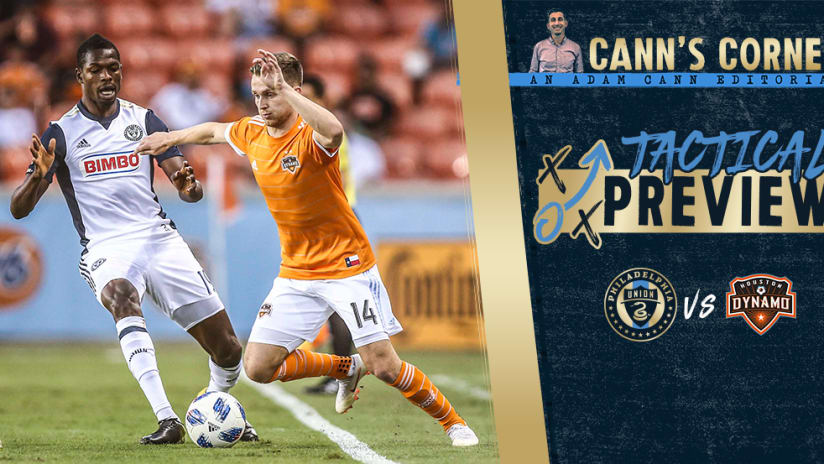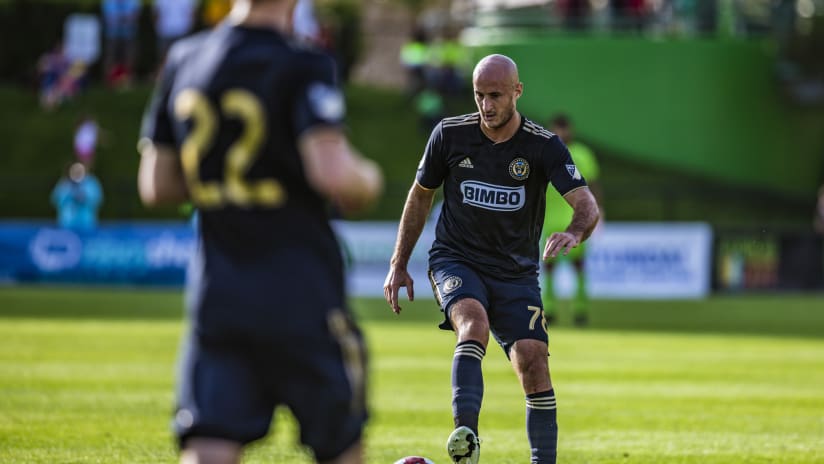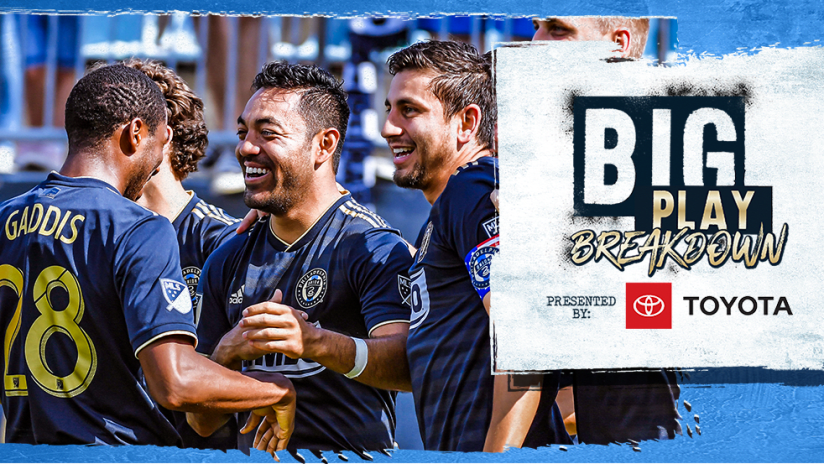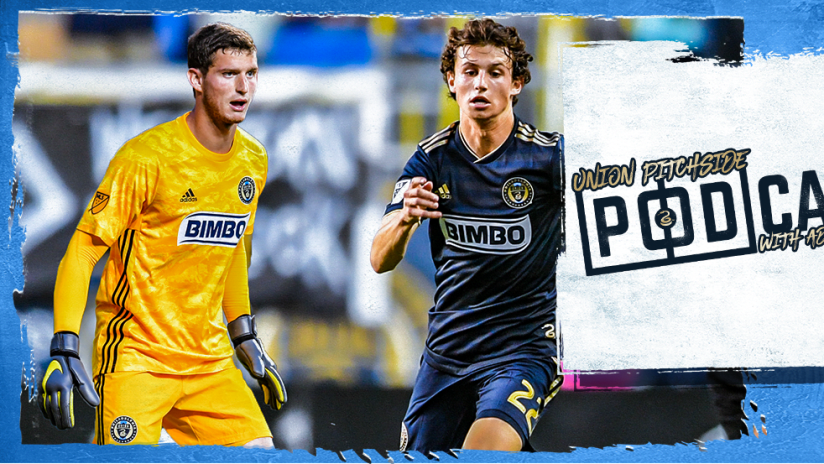“The team that dictates the rhythm of the game and is organized” is how Jim Curtin characterized how fans can get a sense of who is on top during Wednesday night’s US Open Cup final in Houston (8PM EST on ESPN2).
The Union and Dynamo play contrasting styles, and that means the winner will likely come down to who executes their gameplan more effectively over 90 minutes. For the Union, it’s all about gaining possession quickly after losing it, and moving the ball with speed and purpose once it’s under control. For the Dynamo, playing the first pass out of pressure after winning a turnover will allow them to find outlets to their front four, and those guys are just sensational in space. On form alone, the Union are probably favored in this one. But with the attacking talent at Wilmer Cabrera’s disposal, this is a match that will be able to change in an instant.
Houston attack
The Dynamo attack is in the top half of the league, and rightly so. Across the front line, Houston has weapons that can hurt you a number of different ways. Let’s look at each danger man individually.
Mauro Manotas: 14G, 0A in MLS; 4G in USOC
It’s not that Manotas is mobile, it’s that he’s mobile and intelligent. Listed at 6’0”, the 23-year old Colombian has blossomed over the past two seasons, topping his 10 goal 2017 output with 14 this year.
The importance of Manotas to the Houston attack cannot be overstated. The Dynamo’s wingers are both extremely difficult to cover 1v1, so if teams want to leave their own wingers high they need to support their fullbacks from the center. This can leave Manotas will a lot of territory to prowl, and his proactive running causes all sorts of issues to the opposition.
Romell Quioto: 4G, 11A in MLS
The Swiss Army Knife of Houston Dynamo’s offense, Quioto can do it all. Seven goals and three assists in 2017 followed up by a four goal/11 assist season this year is exactly what a scary winger produces. With Alberth Elis on the right, Quioto is responsible for helping work the ball out of the back when Houston can’t immediately break out upfield.
Last time Houston and Philly met, Quioto helped bring the ball up the left flank before the Dynamo accessed the center and Manotas beat the center backs to score.
The key to stopping Quioto… well, there might not be a key. He’s so versatile that the goal should be to contain the winger and ensure that he has to keep his head down. While Quioto’s wing partner likes to drive low crosses behind the defense, Quioto can both put low crosses in and lift well-weighted balls over the defense. Thus, you cannot just keep him in front of you but instead must get tight enough to limit his vision and hope that your support gets into position.
Alberth Elis
The true gem of Houston’s system, Elis can be an absolutely unstoppable force up the right. His combined Expected Goals and Expected Assists per game in MLS since the Union played Houston in late July is up there with the best in the league. That means Josef Martinez, Giovinco, and Zlatan territory. Truly impressive.
Elis has unbelievable change of pace, and since Houston doesn’t give him much defensive responsibility, he can drift into spaces that allow him to get a runway at defenders. Similar to how Chaco Maidana would stay high and seek out enough space to play counterattack conductor for Jim Curtin’s early teams, Elis is allowed to look for the most dangerous places to hang so he can, well, do what he does.
Tomas Martinez
He’s an underrated part of the Houston attack, but Martinez’s ability to play balls through the lines can ramp up Houston’s threat level to 11. Since both Quioto and Elis like to stay wide, they can create big spaces between fullbacks and center backs. Martinez targets these spaces and has a knack for backspin that kills a ball after it penetrates a defensive line and before it reaches the box. With the speed Houston has up top — and the intelligence of Manotas in the center, who weaves off of defenders into the holes opened by the wingers, Martinez can kickstart Houston’s offense even if they can’t immediately get the ball forward.
The catch is that Martinez is a bit of a wanderer on defense. The Dynamo don’t always play him on top of their two holding midfielders, but instead sit him to the right of the other two. This allows Martinez to offer help to the right fullback since Elis isn’t coming back unless he absolutely has to.
If Martinez isn’t well-positioned, though, or if he drifts apart from the other two mids, this can leave unmarked space for Borek Dockal. And if there is one superpower that the Czech playmaker has displayed throughout 2018, it is space-finding in a loose midfield.
Combined, Houston’s attackers look to create transition opportunities off of turnovers. This means breaking forward with speed and spreading out a defense so the individual attackers have qualitative skill advantages over their defenders. Manotas will read the development of a play and either check back off of the center backs or curl into a hole behind fullbacks that get separated from their defensive line.
Importantly, Houston is likely to only attack with four unless the Union can successfully keep those danger men in front of them. If this occurs, and the Dynamo need to recycle play, Jim Curtin’s former teammate Damarcus Beasley will scoot forward from left back to support Quioto and create triangles with Darwin Ceren or Martinez. The goal here is not always to beat a defense as much as draw it out of the box so Beasley and Quioto can serve onto Manotas’ head.
Houston defense
This is where the Dynamo become a bit of a mystery. They look wide open after turnovers… but they don’t actually give up a ton of goals. 42 on the season is fourth best in the west, and American Soccer Analysis’ team xG model has them as the third best defensive team in the conference this year.
The way to get at the Dynamo is to find ways to directly attack their center backs. In the opening moments of Houston’s last match against Orlando City, the home side played a simple vertical ball through the lines that nearly led to an easy chance. One player checked off Houston’s Alejandro Fuenmayor and, after a beat, the center back followed. Unfortunately, he had not checked his right shoulder, which would have shown him that another attacker was inside of Kevin Garcia. The resulting ball out of midfield — a simple, straight ball directly into the heart of Houston’s defense — skipped past Fuenmayor and released Orlando in behind.
Similarly, when the Union defeated Houston in July, both goals came from Borek Dockal positioning himself in front of the back line so defenders were forced to make decisions about whether to come out or hold their spot. When they delayed, Dockal punished them to the tune of two balls through the lines — first to Ale Bedoya, then Cory Burke.
Getting to those center backs isn’t easy, though. In July, a well-coordinated press from the front four forced Dockal deep to receive the ball, and the Union were only able to gain penetration after Martinez was red carded. Against Orlando City, Houston adopted something more akin to what Montreal used to stifle Philly’s attack: A deep shape primed for breakouts.
This deep shape sits Martinez alongside the holding midfielders with everyone protecting the center. Space is granted on the flanks, but if Philly dawdles a winger will drop in and help try to pry the ball loose.
Union style of play
As the team more likely to be proactive with the ball, the Union will need to find ways to break down Houston’s deep defensive block. The fundamental principles here are fast ball movement and good spacing.
It is likely, given the Union’s approach in many games this season, that the Union will attack up the right side of the pitch more often than the left. They will overload that side using Ale Bedoya, which should draw an extra midfielder to the flank. The question is: What comes next?
Dockal will intelligently exchange positions with CJ Sapong and Keegan Rosenberry, often hanging wide as the defense rotates back across the field. If this happens, it can leave Dockal free in the final third, but it can also put the Union in a poor defensive shape if they lose the ball.
The solution to this is the idea of possession defending that the Union coaches emphasize so frequently in training. To be a possession-oriented team, you must be in good positions to defend when you lose the ball, because by nature of your dynamic movements, you may be far from your traditional positions. Thus, a major key to the Union’s attack — and the one that will allow them to create the rhythm and movements that can draw Houston out in a way that did not happen often enough against the Impact.
Small things
Seemingly minor things that may make a huge difference for Philly are:
Can Keegan Rosenberry force Romell Quioto to drop deeper than he wants to be? And, relatedly, can Jack Elliott or Mark McKenzie then follow Mauro Manotas into the space that will inevitably leave behind without leaving the center wide open for attacks? Regardless of how strong Houston is up the flanks, a soft center can always lead to big problems in a hurry.
Can Fafa Picault dominate the right side of Houston’s defense? Picault has been a relentless force over the past few months, and he has been Philly’s late game hero more than once over that period. Additionally, Picault has been an absolute monster on the road. If Houston commits to the right to combat the Union’s strong combination play up that wing, Picault will have a lot of space on the left. Once he has the ball, what can the winger do to create his own shot or a shot for others?
Can Philly keep a high defensive line without Tomas Martinez and Houston finding ways to continually get into space behind? It’s hard to keep track of the height of a defensive line on television, but do your best! Controlling the space in which the game is played will be essential to winning this battle for the Union.
This is a final. So no matter how it happens, no matter how hard they have to work, you know Jim Curtin’s men will do it. The past two times they made it this far, there is absolutely no questioning how hard the Union worked. Even though they came up short, they showed a readiness for finals that will surely translate to Houston on Wednesday evening.
So get ready. It’s a final. It means everything to the players, and they are going to give everything they have to bring a trophy back to Philadelphia.













